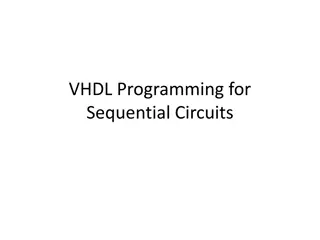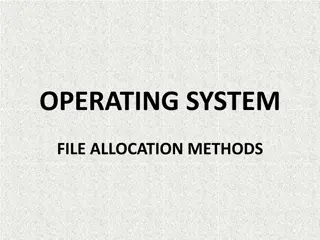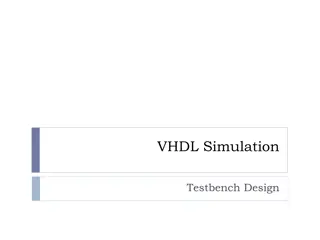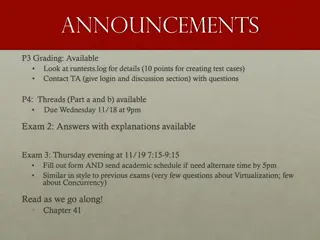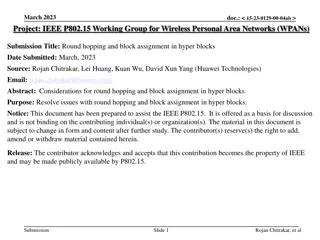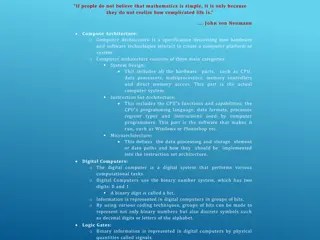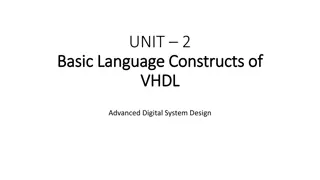Introduction to VHDL Building Blocks
Fundamental building blocks of a computer system using VHDL, including combinational and sequential circuits, state machines, flip-flops, decoders, multiplexers, latches, and more. Learn how to design digital systems and CPUs using VHDL for various applications.
Uploaded on Feb 22, 2025 | 0 Views
Download Presentation

Please find below an Image/Link to download the presentation.
The content on the website is provided AS IS for your information and personal use only. It may not be sold, licensed, or shared on other websites without obtaining consent from the author.If you encounter any issues during the download, it is possible that the publisher has removed the file from their server.
You are allowed to download the files provided on this website for personal or commercial use, subject to the condition that they are used lawfully. All files are the property of their respective owners.
The content on the website is provided AS IS for your information and personal use only. It may not be sold, licensed, or shared on other websites without obtaining consent from the author.
E N D
Presentation Transcript
1 VHDL 4 : (ver.7a) VHDL 4 Building blocks of a computer
2 VHDL 4 : (ver.7a) VHDL 4 Building blocks of a computer Combinational circuit and sequential circuit Building blocks of a computer. Control units are state machines, which have Flip-flops, decoders, multiplexers etc. Beware that , there are usually more than one way to design the same digital system in VHDL
3 VHDL 4 : (ver.7a) Combinational Vs. Sequential ciruits Combinational circuit, it has no memory Example: decoder, encoder, inverter Sequential circuit, it has memory Circuits that change state and output according to some conditions, (input or clock) Examples: Sequential Latch, Flip-flops (FFs) with asynchronous or synchronous reset; Combinational tri state buffer; decoder; multiplexer, bi-directional buffer,
4 VHDL 4 : (ver.7a) A typical CPU FFs=Flip-flops A state machine contains FFs Control Unit State machine Registers (FFs) Address bus I/O control logic (latches) (state machine) data-bus ALU Transceivers (state machine) Memory (bi-directional buffers )
5 VHDL 4 : (ver.7a) Use VHDL to make digital system building blocks 1) latch, 2) flipflop with asynchronous reset, 3) flipflop with synchronous reset, 4) tri state buffer, 5) decoder, 6) multiplexer, 7) bi-directional buffer,
6 VHDL 4 : (ver.7a) VHDL Exercise 4 1) Latch: when gate=1, output follows input (level sensitive) Latch 1-bit memory in1 gate D Q C out1 1) library IEEE;--(ok vivado 2014.4) 2) use IEEE.STD_LOGIC_1164.ALL; 3) entity latch_ex is 4) port (gate, in1 : in std_logic; 5) out1 : out std_logic); 6) end latch_ex; 7) architecture latch_ex_arch of latch_ex is 8) begin 9) process (gate,in1) 10) begin 11) if (gate = '1') then 12) out1 <= in1; 13) end if; 14) end process; 15) end latch_ex_arch; sensitivity list http://faculty.kfupm.edu.sa/COE/ashraf/Ric hFilesTeaching/COE022_200/Chapter4_1.ht m, or P.72 Advanced Digital Design with the Veriolog HDL by M.D. Ciletti The process executes once when gate or in1 changes
7 VHDL 4 : (ver.7a) Exercise 4.1 on latch: draw q Latch q In1 gate in1 gate q
8 VHDL 4 : (ver.7a) 2) Edge-triggered Flip-flop with asyn. reset : reset before clock statement 1) library IEEE;--(ok vivado 2014.4) 2) use IEEE.STD_LOGIC_1164.ALL; 3) entity dff_asyn is 4) port (in1,clock, asyn_reset: in std_logic; 5) out1 : out std_logic); 6) end dff_asyn; 7) architecture dff_asyn_arch of dff_asyn is 8) begin 9) process(clock, asyn_reset) 10) begin 11) if (asyn_reset = '1') then 12) out1 <= '0'; 13) elsif clock = '1' and clock'event then 14) out1 <= in1; 15) end if; 16) end process; 17) end dff_asyn_arch; asyn_reset Edge (50%) Clock triggered FF Q in1 sensitivity list clock Explain the meaning of 50 % clock trigger for a Flip Flop. edge triggered clock or rising_edge(clock) Asyn_reset is 0 clock in1 Draw (out1)
9 VHDL 4 : (ver.7a) Exercise 4.3 on architecture dff_asyn_a When will line 9 be executed? Which is more powerful: clock or reset? 1) library IEEE;--(ok vivado 2014.4) 2) use IEEE.STD_LOGIC_1164.ALL; 3) entity dff_asyn is 4) port (in1,clock, asyn_reset: in std_logic; 5) out1 : out std_logic); 6) end dff_asyn; 7) architecture dff_asyn_arch of dff_asyn is 8) begin 9) process(clock, asyn_reset) 10) begin 11) if (asyn_reset = '1') then 12) out1 <= '0'; 13) elsif clock = '1' and clock'event then 14) out1 <= in1; 15) end if; 16) end process; 17)end dff_asyn_arch; For asynchronous reset flipflop asyn_reset and clock must be in the sensitivity list
10 VHDL 4 : (ver.7a) 3) Flip-flop with syn. reset: clock before reset statement 1) library IEEE;--(ok vivado 2014.4) 2) use IEEE.STD_LOGIC_1164.ALL; 3) entity dff_syn is 4) port (in1,clock, syn_reset: in std_logic; 5) out1 : out std_logic); 6) end dff_syn; 7) architecture dff_syn_arch of dff_syn is 8) --begin process(clock,syn_reset) -- 'syn_reset' can be removed, 9) begin process(clock) -- 'syn_reset' can be removed, 10) begin 11) if clock = '1' and clock'event then 12) if (syn_reset = '1') then 13) out1 <= '0'; 14) else 15) out1 <= in1; 16) end if; 17) end if; 18) end process; 19) end dff_syn_arch; the sensitivity list edge triggered clock out1 syn_reset in1 D clock Discuss why syn_reset is not needed in
11 VHDL 4 : (ver.7a) Difference between Syn. & Asyn. RESET flip-flops (FF) The order of the statements inside the process determines Syn. or Asyn. reset if clock = '1' and clock'event then if (reset = '1') then Syn. Reset Flip-Flop (check clock first) if (reset = '1') then q <= '0'; elsif clock = '1' and clock'event then Asyn. Reset Flip-Flop (check reset first)
12 VHDL 4 : (ver.7a) Exercise 4.4 on different flip-flops **In our course, by default all flip-flops are treated as 50% edge triggered flip-flops. What is the difference between synchronous reset (syn-reset) flip-flops and asynchronous reset (asyn-reset) flip-flops? Discuss the difference between a latch and a flip flop.
13 VHDL 4 : (ver.7a) 4) Tri state buffer: using when-else (Use capital letter big Z for float, Z is a reserved character) remember: Z is a scissor 1) library IEEE;--(ok vivado 2014.4) 2) use IEEE.STD_LOGIC_1164.ALL; 3) entity tri_ex is 4) port (in1, control : in std_logic; 5) out1 : out std_logic); 6) end tri_ex; 7) architecture tri_ex_arch of tri_ex is 8) begin 9) out1 <= in1 when control = '1' else 'Z'; 10) end tri_ex_arch; control out1 in1 Z=float
14 VHDL 4 : (ver.7a) A decoder (N bits --> 2N bits) Picture from: http://www.safesdirect.com/safes/meilink/safes.html
15 VHDL 4 : (ver.7a) 5) Decoder: using if statements sensitivity list library IEEE;--(ok vivado 2014.4) use IEEE.STD_LOGIC_1164.ALL; entity decoder_ex is port (in1,in2 : in std_logic; out00,out01,out10,out11 : out std_logic); end decoder_ex; architecture decoder_ex_arch of decoder_ex is begin process (in1, in2) 10) begin 11) if in1 = '0' and in2 = '0' then 12) out00 <= '1'; 13) else 14) out00 <= '0'; 15) end if; 16) if in1 = '0' and in2 = '1' then 17) out01 <= '1'; 18) else 19) out01 <= '0'; 20) end if; 1) 2) 3) in='1' and in2='0', open the safe 4) 5) 6) 7) 8) 9) out00 in1 out10 case 1 out11 in2 out01 case 2
16 VHDL 4 : (ver.7a) (contin.)Decoder 21) if in1 = '1' and in2 = '0' then 22) out10 <= '1'; 23) else 24) out10 <= '0'; 25) end if; 26) if in1 = '1' and in2 = '1' then 27) out11 <= '1'; 28) else 29) out11 <= '0'; 30) end if; 31) end process; 32) end decoder_ex_arch; case 3 (open the safe) case 4
17 VHDL 4 : (ver.7a) 6) Multiplexer (2N bits --> Nbits) (the reverse of decoder) 1) library IEEE;--(vivado 2014.4 tested ok) 2) use IEEE.STD_LOGIC_1164.ALL; 3) entity mux is 4) port (in1,in2, ctrl : in std_logic; 5) out1 : out std_logic); 6) end mux; 7) architecture mux_arch of mux is 8) begin 9) process (in1, in2, ctrl) 10) begin 11) if ctrl = '0' then 12) out1 <= in1; 13) else 14) out1 <= in2; 15) end if; 16) end process; end mux_arch; in1 out1 in2 crtl in1 out1 Mux in2 crtl
18 VHDL 4 : (ver.7a) Note:7) Bi-directional bus: using data flow concurrent statements library IEEE;--(ok vivado 2014.4) 2) use IEEE.STD_LOGIC_1164.ALL; 3) entity inout_ex is 4) port (io1, io2 : inout std_logic; 5) ctrl : in std_logic); 6) end inout_ex; 7) architecture inout_ex_arch of inout_ex is 8) begin 9) io1 <= io2 when ctrl = '1' else 'Z'; 10) io2 <= io1 when ctrl = '0' else 'Z'; 11) end inout_ex_arch; 1) ctrl io1 io2 concurrent statements
19 VHDL 4 : (ver.7a) Exercise 4.5 for Bi-directional bus Crt=1, io1 follows io2_in Crt=0, io2 follows io1_in Plot io1 io2 ctrl io2 io1 Io1_in Io2_in R=10K R=10K ctrl Io1_in io1 Io2_in Io2
20 VHDL 4 : (ver.7a) Exercise 4.6 List whether the following circuits are sequential or combinational and discuss the reasons Circuit name Sequential or combinational Condition for state change if sequential discussion latch Flip flop tri state buffer Decoder Multiplexer, Bi-directional buffer
21 VHDL 4 : (ver.7a) (ANSWER ) Exercise 4.6 List whether the following circuits are sequential or combinational and discuss the reasons Circuit name Sequential or combinational Condition for state change if sequential Input state Clock edge discussion latch Flip flop Sequential Sequential Has memory Has memory tri state buffer Decoder Multiplexer, Bi-directional buffer combinational N.A. No memory combinational combinational combinational N.A. N.A. N.A. No memory No memory No memory
22 VHDL 4 : (ver.7a) Quick revision You should know how to design asynchronous , synchronous reset flip-flops tri state buffers, Combination logics decoders, multiplexers, bi-directional buffers,
23 VHDL 4 : (ver.7a) Appendix: do variables in processes have memory. (Good practice: Initialize variables before use; assign values to variables from input first) library IEEE; use IEEE.std_logic_1164.all; entity test is port (a,reset_v1: in std_logic; b ,c: out std_logic); end test; architecture test_arch of test is begin label_proc1: process (a,reset_v1) variable v1 : std_logic; begin if reset_v1 ='1' then end if; b<=a; c<=v1; end process label_proc1; end test_arch; v1:= not a; V1 stays at two different levels depending on previous result **The answer is yes. That means after a process is called, the state of a variable will be stored for the next time the process is being run again.
24 VHDL 4 : (ver.7a) Turn VHDL into schematic Use Schematic viewer in ISE project navigator
25 VHDL 4 : (ver.7a) How to represent binary and hex numbers Type Standard logic( with initialized values): signal code_bit : std_logic := 1 ; --for one bit , init to be 1 , or 0 signal codex : std_logic_vector (1 downto 0) := 01 ; -- 2-bit signal codey : std_logic_vector (7 downto 0) :=x 7e ; --8-bit hex 0x7e



